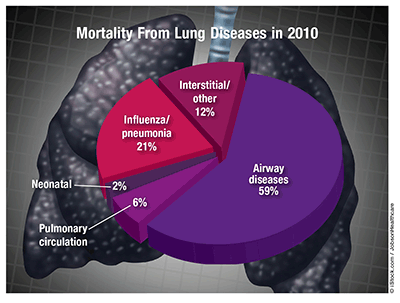US Pharm. 2015;40(7):35.
According to the National Center for Health Statistics, respiratory diseases in 2010 cost $129.4 billion, of which 24% was an indirect cost of mortality. Lung diseases (excluding lung cancer) were responsible for about 235,000 deaths.

Airway Diseases: Chronic lower respiratory disease (CLRD), which includes bronchitis, emphysema, and asthma, is characterized by shortness of breath caused by airway obstruction. CLRD affects millions of people, caused 138,000 deaths in 2010, and is projected to rise to the third leading cause of death in 2020. In infants, the mortality rate from CLRD in 2010 was 0.6 per 100,000 among those aged <1 year, and the death rate increased with progression of age. There was a fourfold increase in mortality in persons aged 55 to 64 years compared with those aged 45 to 54 years, after which the rate of increase declined progressively with age to 90% between the ages of 75 to 84 years and ≥85 years. Compared with women, the CLRD-related death rate per 100,000 men was higher among non-Hispanic black, Asian/Pacific Islander, and Hispanic persons. In non-Hispanic white and American Indian/Alaska Native populations, the death rate was higher in women. The overall mortality rate was higher in women than in men.
Influenza/Pneumonia: Infants aged ≤1 year had the highest rate of death from influenza or pneumonia (4.5/100,000). The number of individuals dying from influenza or pneumonia increased with age, but numbers were disproportionate across age groups. A 2.4-fold (i.e., 240%) increase in mortality occurred between the ages of 55 to 64 years and 65 to 74 years; the increase between ages 65 to 74 years and 75 to 84 years was 3.5-fold (350%), and the increase was 4.3-fold (430%) between ages 75 to 84 years and ≥85 years. There was no disparity among ethnic groups, but for every 100,000 individuals, 10% more deaths occurred among women (18.8) compared with men (17.2). Non-Hispanic white men (21.3) and women (23.8) had the highest mortality rates.
Interstitial Lung Disease: Interstitial lung disease (ILD) in infants and children is a large spectrum of rare respiratory disorders that are mostly chronic and associated with high morbidity and mortality (~15%). ILD in infants and young children is linked to lung-development problems and lung injury. The prevalence of ILD is higher in younger patients, as >30% of patients are aged <2 years at diagnosis. About 7% of patients have parental consanguinity, and in nearly 10% of cases, siblings are afflicted with similar diseases. ILD has a male predominance, with a sex ratio of 1 to 4.
To comment on this article, contact rdavidson@uspharmacist.com.





